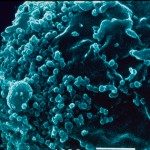Lien vers Pubmed [PMID] – 16470117
AIDS 2006 Feb;20(4):533-42
OBJECTIVES: Human thymus can be infected by HIV-1 with potential consequences on immune regeneration and homeostasis. We previously showed that CD4 thymocytes preferentially replicate CXCR4 tropic (X4) HIV-1 dependently on interleukin (IL)-7. Here we addressed the susceptibility of thymic dendritic cells (DC) to HIV-1 infection.
METHODS: We investigated the replication ability of CXCR4 or CCR5 (R5) tropic HIV-1 in thymic micro-explants as well as in isolated thymic CD11clowCD14- DC, CD11chighCD14+ DC and plasmacytoid DC subsets.
RESULTS: Thymic tissue was productively infected by both X4 and R5 viruses. However, X4 but not R5 HIV-1 replication was enhanced by IL-7 in thymic micro-explants, suggesting that R5 virus replication occurred in cells other than thymocytes. Indeed, we found that R5 HIV-1 replicated efficiently in DC isolated from thymic tissue. The replicative capacity of X4 and R5 viruses differed according to the different DC subsets. R5 but not X4 HIV-1 efficiently replicated in CD11chighCD14+ DC. In contrast, no HIV-1 replication was detected in CD11clowCD14- DC. Both X4 and R5 viruses efficiently replicated in plasmacytoid DC, which secreted interferon-alpha upon HIV-1 exposure. Productive HIV-1 infection also caused DC loss, consistent with different permissivity of each DC subset.
CONCLUSIONS: Thymic DC sustain high levels of HIV-1 replication. DC might thus be the first target for R5 HIV-1 infection of thymus, acting as a Trojan horse for HIV-1 spread to thymocytes. Furthermore, DC death induced by HIV-1 infection may affect thymopoiesis.
